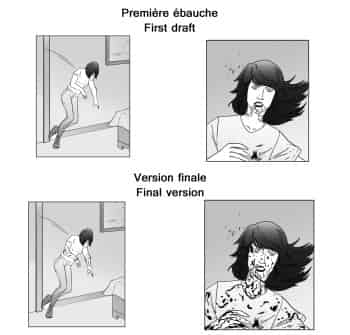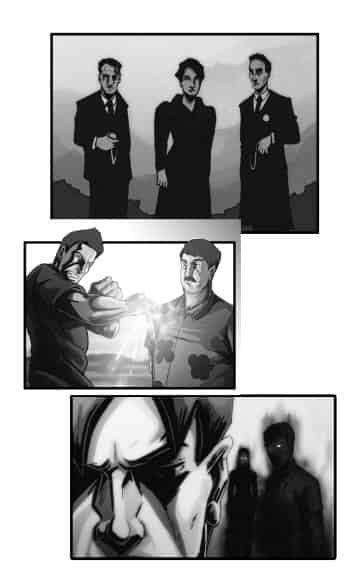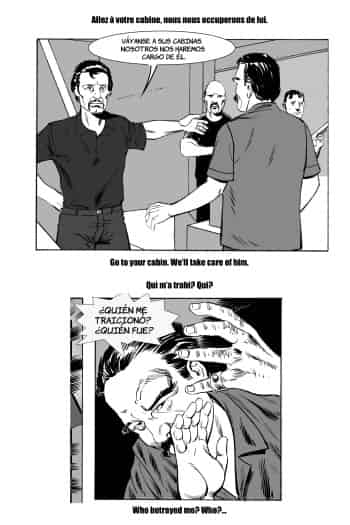Bonus
-
Touch-ups (Virus Part III)
-
Story twists as an obstacle course
A few months ago broadcast TV offered us the series Strike Back, which in our opinion is a lot like the series 24. The more episodes we watched, the more we would see the screenwriters stretching out the plot to make it last 12 or 24 episodes. The need to create twists and turns in the story to keep the viewer’s interest, instead of focusing on a denser storyline, makes the overall plot seem like an obstacle course. We’re not saying it makes for bad TV. On the contrary, it’s fun to watch. But we do feel it had potential that could have been drawn out more convincingly.
Similarly the plot of our story “Plunging into the Depths,” whose original title was “Race against Time,” was quite different in the first draft. The plot wasn’t even finished with 95 panels because we were writing following an obstacle-course model: a first event leading to a second, etc. However the further along we got, the less the story seemed to work. So we eliminated a lot of stuff and kept only the essential elements: the watches that might have some signification, the gadget creating an invisible protective wall, and Fabien’s strange, mystical meeting with deceased colleagues. In the end the story was much shorter, more direct, and in our opinion, much more pleasing.
-
But what were they saying? (Boarding party)
-
Story density
In the initial story design, the secondary storyline of “Vultures” was only supposed to cover past events, and the “Exile” storyline would cover Benson’s life. However along the way we decided to use these storylines as a more direct complement to the events in the main storyline “Cycle of Shadows.” This new formula gives us more flexibility to develop the story.
-
The viability of webcomics
We’re coming back to ideas we’ve already discussed but with new references that provide food for thought. Brian Wood recalls a simple truth about the comic book industry: “This is a job. This is a business, not a hobby or a social activity. That may sound a little cold, and it doesn’t mean I don’t get immense creative satisfaction from doing what I do (if I didn’t, I’d go be a stockbroker or something) but it’s about finding the right balance. Not making business decisions based on being a fan, or social pressure, or making too many allowances for the quirks of this industry” (Graem McMillan, “Wood: Comics is a Business, Not a Hobby or a Social Activity,” Newsarama, January 2, 2013).
Falcone however adds an important nuance that makes a big difference: the idea of teamwork. “Compared to other industries, I find it surprising and overwhelming how pedagogy and mentorship is so deeply ingrained as part of the comic book industry. I’ve seen creator after creator look at someone’s work and give advice and pass on years of wisdom because someone did it for them. Comic creators believe in returning kindness and helping aspiring talent” (Anthony Falcone, “Breaking into the Comics the Marvel Way,” www.comicbookdaily.com, May 30, 2013).
Despite this, the commercial aspect can’t be ignored because creating comics costs money even if you are publishing your work online yourself. This is because comic require a high production rate, which entails certain labour costs (“Mark Waid on the True Cost of Digital,” http://www.comicsbeat.com, January 1, 2013).
These costs mean that even artists like Mark Waid wonder about how to generate revenue (“Holiday Interview #22 – Mark Waid,” www.comicsreporter.com, January 22, 2013). In the same interview Waid sees the industry moving to a more direct and personal relationship between creator and fans. In such an environment how is it possible to generate mass revenues without losing the direct contact?






